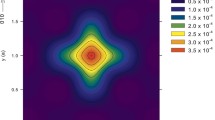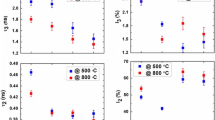Abstract
Single crystals of GaP and InSb were irradiated by 3 MeV electrons at 20 K to a total dose of 4 × 1018 e −/cm2. Isochronal annealing in the temperature region 77–650 K followed the irradiation. In GaP, the positron lifetime measurement indicated the presence of irradiation-induced vacancies in the Ga-sublattice. The vacancies disappeared at two stages observed in temperature ranges 200–300 and 450–550 K. In InSb the positron lifetime was found to increase by 8 ps compared to that in as-grown crystals (i.e. 282±2 ps) after irradiation. The increase indicated the presence of irradiation-induced defects; the crystal was found to recover until 350 K with a sharp annealing stage at 250–350 K.
Similar content being viewed by others
References
Aukermann L W 1959Phys. Rev. 115 1125
Barnes C E 1972Appl. Phys. Lett. 20 110
Brudnyi V N, Vorobiev S A and Tsoi A A 1982aAppl. Phys. A29 219
Brudnyi V N, Vorobiev S A and Tsoi A A 1982bPhys. Status Solidi A72 529
Brudnyi V N, Vonobiev S A, Tsoi A A and Shahovtsov V I 1983Radiat. Eff. 79 123
Dannefaer S and Kerr D 1986J. Appl. Phys. 60 591
Dannefaer S, Mascher P and Kerr D 1986Phys. Rev. Lett. 56 2195
Das Sharma S and Madhukar A 1981Phys. Rev. B24 2051
Dlubek G and Brummer O 1986Ann. Phys. (Leipzig) 43 178
Dlubek G, Brummer O, Plazaola F and Hautojarvi P 1986aJ. Phys. C19 331
Dlubek G, Brummer O and Polity A 1986bAppl. Phys. Lett. 49 385
Dlubek G, Krause R, Brummer O and Tittes J 1987Appl. Phys. A42 125
Elsen F H 1961Phys. Rev. 123 736
Elsen F H 1966Phys. Rev. 148 828
Hautojarvi P, Moser P, Stucky M and Corbel C 1986Appl. Phys. Lett. 48 809
Mooney P M and Kennedy T A 1984J. Phys. C17 6277
Moser P, Pautrat J L, Corbel C and Hautojarvi P 1985Proc. VII Int. Conf. on Positron Annihilation (eds) P C Jain, R M Singru and K P Gopinathan (Singapore: World Scientific) pp. 722–725
Puska M J 1987aPhys. Status Solidi A 102 11
Puska M J 1989Mater. Sci. Forum Vols. 10 to 12, p. 277
Sen Gupta A, Naidu S V and Sen P 1986Appl. Phys. A40 95
Sen Gupta A, Naidu S V, Roy R and Sen P 1986Solid State Commun. 58 219
Sen Gupta A, Moser P, Corbel C and Hautojarvi P 1988Cryst. Res. Technol. 23 409
Stucky M, Paulin R, Geffroy B, Corbel C and Suskij J 1985Proc. VII Int. Conf. on Positron Annihilation (eds) P C Jain, R M Singru and K P Gopinathan (Singapore: World Scientific) pp. 714–716
Von Bardeleben J H (ed.) 1986Defects in semiconductors I–III (Aedermannsdorf: Materials Science Forum) vols. 10–12
Vook F L 1964Phys. Rev. 135 A1750
Author information
Authors and Affiliations
Rights and permissions
About this article
Cite this article
Gupta, A.S. Characterisation of vacancy-like defects in III–V compound semiconductors using positron annihilation technique. Bull. Mater. Sci. 13, 89–94 (1990). https://doi.org/10.1007/BF02744862
Issue Date:
DOI: https://doi.org/10.1007/BF02744862




